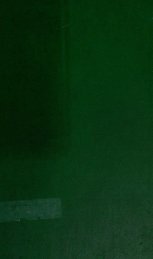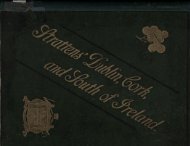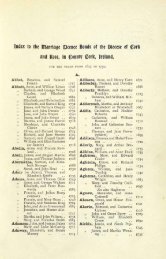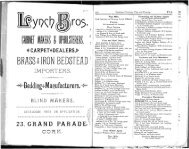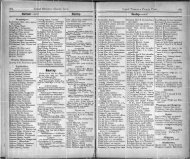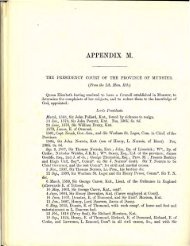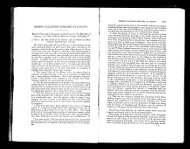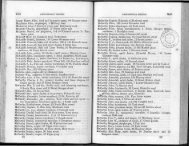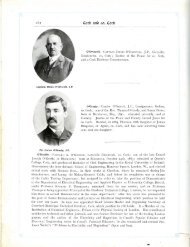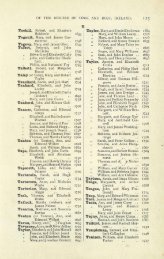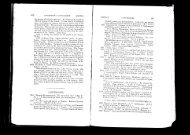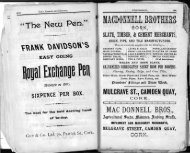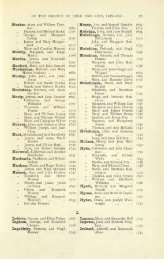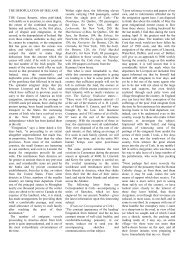liscarroll Parish. - Cork Past and Present
liscarroll Parish. - Cork Past and Present
liscarroll Parish. - Cork Past and Present
Create successful ePaper yourself
Turn your PDF publications into a flip-book with our unique Google optimized e-Paper software.
LISCARROLL PARISH. 25<br />
of Newmarket, who fought at the Boyne <strong>and</strong> at the Siege of Limerick,<br />
<strong>and</strong> who married Elizabeth, daughter of Sir John Philpot of Newmarket<br />
(see Aldworth Pedigree) by Alice, daughter of Sir Robert Travers, by<br />
Elizabeth, daughter of the Primate Richard Boyle, Archbishop of Tuam<br />
<strong>and</strong> Lord Chancellor of Irel<strong>and</strong> ancestor of the Earls of <strong>Cork</strong> <strong>and</strong> Orrery<br />
<strong>and</strong> the Earls of Shannon. Sir Robert Travers was Judge Advocate in<br />
Irel<strong>and</strong> <strong>and</strong> Vicar General of <strong>Cork</strong>, <strong>and</strong> was killed at the Battle of<br />
Knockinoss near Mallow, 13th November, 1647. He was son of John<br />
Travers, who came to Irel<strong>and</strong> when Lord Grey de Wilton came over as<br />
Lord Lieutenant. "This John Travers married Sarah Spenser, the sister<br />
of Edmund Spenser the poet, who granted him as a marriage portion with<br />
his sister the townl<strong>and</strong>s of Ardenbane <strong>and</strong> Knocknaple in Roche's Country<br />
in the County of <strong>Cork</strong>, which was part of the forfeited estate of the Earl of<br />
Desmond, granted by Queen Elizabeth to the said Edmund Spenser, in<br />
which grant Kilcolman Castle <strong>and</strong> Lake were comprised. The abovenamed<br />
John Travers <strong>and</strong> Sarah Spenser had two sons, Rolbert Travers the<br />
eldest, afterwards Sir Robert Travers, who married Elizabeth, daughter of<br />
the Primate Boyle," as above, <strong>and</strong> Zachery Travers, whose estates were<br />
devised to John Travers, the second son of Sir Robert Travers. (See Brady,<br />
P a £ e s SS^S 2 * etc., <strong>and</strong> Lodge.)<br />
<strong>liscarroll</strong> <strong>Parish</strong>.<br />
Sheet 16, 6-inch O.S. Sheet 164, i-inch O.S.<br />
Barony of Orrery <strong>and</strong> Kilmore.<br />
It lies about 7 miles (by road) N.W. of Buttevant Village.<br />
Liscarroll is the Irish for ''Carroll's Fort." (O'Donovan.)<br />
FIANTS OF ELIZABETH.<br />
3287 (6121). License to James Viscount Barrie to alien to Nicholas<br />
Walshe, John Bayes, <strong>and</strong> Christopher Arthur, the barony or hundred of<br />
Oryrry, <strong>and</strong> the manors <strong>and</strong> l<strong>and</strong>s of Buttevant, Liscarroll, <strong>and</strong> elsewhere<br />
in Co. <strong>Cork</strong>, 6 May xx., A.D. 1578.<br />
Lord Barrymore married in 1621 Alice, eldest daughter of Richard Earl<br />
of <strong>Cork</strong>. After her husb<strong>and</strong>'s death in 1667 she married secondly John<br />
Barry, of Liscarroll. (Journal for 1900, page 202.)<br />
According to the Book of Dist. <strong>and</strong> Sur., circa 1657, Liscarroll <strong>Parish</strong><br />
belonged to Robert Maguire <strong>and</strong> Henry Slingsby, English Papist. They<br />
forfeited the property after the Rebellion of 1642, the grantees being Roger<br />
Bretridge, Richard Boles, <strong>and</strong> Thomas Boles. (P.R.O., Irld.)<br />
Lewis (pub. 1837) states that the parish contained 2,046 inhabitants, of<br />
which number 666 were in the village. He continues : "The parish comprises<br />
3,855 statute acres, as applotted under the Tithe Act. The l<strong>and</strong> in<br />
general JS good <strong>and</strong> chiefly in pasture. Limestone is quarried both for<br />
agricultural purposes <strong>and</strong> for building. The principal seats are Altamira,<br />
e residence of W. Purcell, Esq., a h<strong>and</strong>some mansion in an extensive <strong>and</strong><br />
"cnly planted demesne; High Fort, of R. Purcell, M.D., distinguished for<br />
*e gallant defence 1 made by its then proprietor, the late Sir John Purcell,<br />
1 See Highfort of these Notes.<br />
s<br />
L<br />
•<br />
" ?<br />
*
26 HISTORICAL AND TOPOGRAPHICAL NOTES.<br />
against a midnight attack by nearly 20 robbers, whom, though armed only<br />
with a case knife, he entirely repulsed, in consideration of which intrepid<br />
conduct he obtained the honour of knighthood. Sally Park, the property<br />
of George Bond Lowe, Esq., is now in ruins'' (ii. 281).<br />
The Field Book of 1840 gives: "Liscarroll, a parish under cultivation.<br />
Liscarroll village lies S.W. of the centre. The following country seats<br />
are in it, viz. : Altamira House, Highfort House, <strong>and</strong> Moyge House.''<br />
The townl<strong>and</strong> is also referred to, a Danish fort in the east side, <strong>and</strong> Kate's<br />
Hole (Sheet 15), referred to by Lewis (see under Village). It is said a stone<br />
thrown into it is heard to make a noise in water 20 minutes after being cast<br />
in. (Ord. Sur. Off., Dub.)<br />
In 1881 the area of parish was 4,027a. 2r. 15P; houses, 196; pop., 908;<br />
families, 184; R.C.'s, 891; Prots., 17; val., £3,131. (Guy.)<br />
Altamira is now (1916) the residence of John P. Hannigan, Esq., J.P.,<br />
<strong>and</strong> Highfort that of Daniel S. Wigmore, Esq., J.P.<br />
LISCARROLL PARISH (R.C.)<br />
Sir Daniel Norton of Tysteede, Southampton Co., Knt., was granted the<br />
rectory of Liscarroll, 14 Feb., 3rd Jac. I. It was afterwards granted to<br />
Sir John Jephson, Knt, 21 April, 8th Jac. I. (Pat. Rolls, James I.,<br />
P.R.O., Dublin.)<br />
According to a list made in 1704 it appears that Daniel Daly, living at<br />
Lisgriffin, 80 years of age, was <strong>Parish</strong> Priest of Churchtown <strong>and</strong> Liscarroll.<br />
He received Popish Orders 1650 at Rosse from Richard Connel, Bishop of<br />
Ahaddo <strong>and</strong> Ardfert. Sureties were Timothy Sullivan of Churchtown, ^50,<br />
<strong>and</strong> Dennis Callaghan of Lismealcanning, ^50. (Journal for 1900, p. 56.)<br />
From an abstract made 1731, we find that Liscarroll had one Masshouse,<br />
one reputed Popish priest, no convent of fryars or nuns, <strong>and</strong> one<br />
Popish school. (Journal for 1893, p. 51.)<br />
The Right Revd. Matthew McKenna, R.C. Bishop of Cloyne <strong>and</strong> Ross<br />
in 1785, states that Liscarroll parish was dedicated to the Purification of the<br />
B.V. (Brady, i. lxix.)<br />
Lewis (pub. 1837) gives : "In the R.C. divisions the parish is the head<br />
of a union, comprising also the parish of Churchtown or Bruhenny; the<br />
chapel, an old building, is about to be repaired <strong>and</strong> enlarged. There is also<br />
a chapel at Churchtown. About 80 children are taught in a national school,<br />
<strong>and</strong> there are two private schools, in which are about 200 children (ii. 280).<br />
Windele, writing about 1831, gives : "The chapel, which is a low <strong>and</strong> rude<br />
building of the L form, is, strange to say, thatched, a remnant of a structure<br />
that has disappeared."<br />
The Field Book of 1839 gives: "Liscarroll Monastery. On the south<br />
side of the town of Liscarroll in the N.E. part of Coolbawn are the ruins of<br />
an old monastery or chapel. It is called Liscarroll Church. The west gable<br />
is st<strong>and</strong>ing. There is a graveyard." (Ord. Sur. Off., Dub.)<br />
A <strong>Parish</strong> Priest <strong>and</strong> two Curates do the duty of the parish.<br />
HOLY WELL.<br />
On the north side of the townl<strong>and</strong> of Rockspring to the N. of Liscarroll<br />
Village is a Holy Well by name of "Tubbermurry," Mary's Well—a small<br />
shallow well having an alder tree over it. It is said to be a Blessed Well.<br />
People pray here on Fridays.<br />
-
LISCARROLL PARISH. 27<br />
On the east side of the townl<strong>and</strong> is another well called "Tubberavuchead,"<br />
well of the bucket, a small well where a pump had been erected.<br />
By means of buckets the people g-ot their water; they called it by the name<br />
of "Tubber avuchead." (Field Book for 1839.)<br />
LISCARROLL PARISH (C. OF I.)<br />
Brady gives: 1291<br />
(Tax P. Nic.)<br />
Ecca de Kylscarwyl XXs. unde decia lis."<br />
The following appear to have been the Incumbents, etc., etc.<br />
1591. Patrick Lombard. "R. de Liscarroll pertinet ad Prior Bothon.<br />
Vicarius, Patrick Lombard, laicus, propter defectum sacrorum ordinum et<br />
manifestam contumaciam deprivatus," circiter 1591.<br />
1651. John Temple.<br />
1615. V. Liscarroll, val 3 li. per an. Ecclesia et cancella in ruina.<br />
1615 <strong>and</strong> 1634.<br />
firmarius.<br />
Rectoria impropriata. Johes Jephson, miles, est<br />
l6<br />
34- James Bruce.<br />
1640. Bartholomew Allerton.<br />
1642. Battle of Liscarroll. (See Liscarroll Castle of these Notes.)<br />
1661 <strong>and</strong> 1662. Vacant.<br />
1667. Samuel Alford.<br />
1671. Thomas Wilcox.<br />
1682. Matthew Jones.<br />
1684. Jonathan Falkner.<br />
1694. Val. 7 pounds. Mr. Falkner, Vicar. Thomas Ellis curae<br />
animarum incubit. Epus patronus. Nulla ecclia sed cura animarum<br />
unacum Doneraile curat' commissa est.<br />
1699. Thomas Ellis.<br />
J<br />
705. Kerry Fitzmaurice.<br />
1728. John Murdoch.<br />
1740.<br />
J 774-<br />
Jeremiah King.<br />
Value ;£8o per an. Church in ruins. Patron, the Bp.<br />
A S "iu TaXed b the Kin g' s B ° ok s, £s IQ s. ster. Incumb, Jeremiah King,<br />
A.M. The rect. is imp. Mr. Henry Pearde, Imp. Proxy, 2s.<br />
1785. Protestant pop., 17.<br />
Proxy,<br />
1787. Francis Clement.<br />
From this time the V. Liscarroll has been held with V. Kilbrin, q.v.<br />
I 11 - 304).<br />
In 1604 the rectory of Liscorele (with other rectories) was demised to<br />
aniel Norton of Tyesteede, in Co. Southampton, which were l<strong>and</strong>s <strong>and</strong><br />
possessions of late dissolved abbey of Ballybeg, <strong>and</strong> all other castles, etc.,<br />
said abbey belonging, to hold for 30 years, etc. (Pat. Rolls of James I.)<br />
fn-sn? I }. rectori es <strong>and</strong> tithes of Liscarroll (with other rectories) wer*<br />
Irld ) t0 J ° hn Jephson > Kt '> I2 Dec -> IO J as - G., A.D. 1612. (P.R.O.,<br />
in IT X ? 6 ^; Church in ruins. Francis Price. Price, ESQ.. Esq., imnrooriator. impropriator. Taxed<br />
m Kin<br />
S s Books £s los. (Smith, i. 53.)<br />
L. RETURN OF RENT CHARGES MADE 1853.<br />
Curr S °^ rro » 2 J* Sept ' l8 33> for 21 years, amount of composition, Brit.<br />
seven've^ 4 l ^ at £ l I2S * °* d ' ^ barrel > ^ing avera S e P<br />
yearS endln<br />
S *st Nov., 1830. (Brady, iii. 312.)<br />
rice for
28 HISTORICAL AND TOPOGRAPHICAL NOTES.<br />
•<br />
Lewis (pub. 1837) gives : "The living is a vicarage in the Dio. of Cloyne,<br />
united to that of Kilbrin, together forming the union of Liscarroll, in the<br />
pat. of the Bishop. The rect. is impropriate in C. D. O. Jephson, Esq.<br />
The tithes are equally divided between the Imp. <strong>and</strong> the Vicar. The vicarial<br />
tithes of the benefice amount to ^547. The church is at Ballygrady, on the<br />
border of the parsh of Kilbrin'* (ii. 280).<br />
LISCARROLL CASTLE.<br />
Liscarroll Castle is situated at the N.N.W. side of Liscarroll Village.<br />
It is said to have been built either by John Earl of Morton, afterwards<br />
King John, or by some of the followers of Strongbow. It belonged for many<br />
years to the Barry family. It formed part of a grant to Sir Philip Perceval,<br />
13 March, 1637(8), from Charles I.<br />
In 1641 Sir Philip had the castle garrisoned <strong>and</strong> strongly fortified. He<br />
placed Sergeant (afterwards Captain) Thomas Raymond in comm<strong>and</strong>.<br />
The castle was a quadrangular building, 240 feet long <strong>and</strong> 120 feet wide,<br />
enclosed with walls 30 feet high, <strong>and</strong> defended with two square <strong>and</strong> four<br />
round towers of great strength.<br />
Mr. James Buckley, who visited the ruins circa 1898, gives an account<br />
of its present state in his article on the Battle of Liscarroll (see Journal for<br />
1898, p. 84). He also gives (p. 87) the music of the " Walls of Liscarroll.''<br />
In 1641 Sergt. Thomas Raymond was besieged for 13 days by the<br />
Irish, under General Barry, with a force of 7,000 foot <strong>and</strong> 500 horse <strong>and</strong> a<br />
train of artillery. They arrived before the castle 30th August, <strong>and</strong> placed<br />
their artillery on a hill to the S.E. of the castle <strong>and</strong> within rasi&ket shot of it.<br />
Raymond had only 30 men. He was fortunate in finding a well of good<br />
water in one of the towers (Egmond MSS., i. 155). Although promised<br />
relief the following morning by Lord Inchiquin, comm<strong>and</strong>ing the English<br />
or Parliamentary forces, he surrendered on 2nd Sept. However, the delay<br />
occasioned by the siege allowed Lord Inchiquin to collect a force of about<br />
2,000 foot <strong>and</strong> 400 horse, with which he advanced to Raymond's relief.<br />
The Irish had intended to have marched to Doneraile, but hearing of the<br />
advance of the English, they prepared to give them battle on a plain to the<br />
west of the castle.<br />
On the 3rd Sept. Inchiquin arrived in sight of the castle, <strong>and</strong> found<br />
the Irish drawn up in good order. The English advanced cavalry were<br />
fired on from the castle, which was the first intimation they had that Raymond<br />
had surrendered. The Irish horse <strong>and</strong> musketeers advancing, forced<br />
the English cavalry to retire, during which movement Lord Kinalmeakie<br />
(son of the Great Earl of <strong>Cork</strong>) was killed. The Irish advance was conducted<br />
with great skill <strong>and</strong> dash. The English horse was forced back on their<br />
infantry. The Irish attacking party thereupon rejoined their main body<br />
near the castle.<br />
This was practically an advanced guard action. Each side now prepared<br />
for the battle.<br />
The Irish formed their foot in three bodies, each about 2,000 men. The<br />
right wing occupying some rising ground near a fortification. The left<br />
wing stood close to the castle <strong>and</strong> near their artillery, while the main body<br />
was placed in rear of the centre of the wings <strong>and</strong> consisted mostly of pikes.<br />
The horse was in one body near the right wing on the brow of the hill.<br />
The English were likewise divided into three comm<strong>and</strong>s. The right<br />
-<br />
•
L ' x<br />
LISCARROLL PARISH. 29<br />
wing under Sir Charles Vavasor, consisting of 600 musketeers, faced the<br />
enemy's left wing. The left wing, consisting of 300 musketeers, faced the<br />
opposing right wing. The horse was on the left, facing that of the enemy.<br />
The main body appears to have been about 800 pikes <strong>and</strong> muskets. The<br />
position was on sloping ground 500 yards east of the castle.<br />
The engagement commenced with an artillery duel, with little result.<br />
The English right now prepared to advance. Some musketeers were sent<br />
fgrward to clear an advanced party of Irish foot from some huts, which<br />
ood in a meadow between the two forces. This was effected, the<br />
defenders retiring on their main body. A party of English horse under<br />
Lord Oxenbridge pursued them, <strong>and</strong> advanced so far that he would have<br />
been cut off if other troops had not advanced to his relief. Lord Inchiquin's<br />
troop led the van, but being driven back, threw those following into confusion.<br />
The retreat was successfully covered by 300 muskets, who "that<br />
day did gallant service," which caused the pursuing Irish horse to scatter.<br />
The English troops in h<strong>and</strong> on the left flank advancing, drove back the<br />
enemy's right <strong>and</strong> put them to flight. The victory being followed up by the<br />
English horse, which had this time rallied, Sir Charles Vavasour with<br />
his 600 men attacked <strong>and</strong> drove back the Irish left <strong>and</strong> captured their guns.<br />
The remainder of the Irish army in reserve, seeing both their wings repulsed,<br />
also took to flight. The English army following in pursuit, many Irish were<br />
slain; several escaped through the bogs <strong>and</strong> woods. T^hree pieces of<br />
artillery, 14 colours, <strong>and</strong> 30 wagons were captured, besides 300 muskets. 1<br />
In 1644 the Irish made another attack on Liscarroll Castle. Sergeant<br />
Raymond, the comm<strong>and</strong>er, sallied forth, attacked the enemy <strong>and</strong> defeated<br />
the whole body. (Smith, ii. 97.)<br />
In 1645 Lord Castlehaven, in comm<strong>and</strong> of the Irish, took most of the<br />
strongholds in the county, "which success had such an effect on Liscarroll<br />
that it surrendered without firing a shot, though in the best position for<br />
defence (Smith, ii. 87, <strong>and</strong> Egmont MSS). Raymond was put under arrest<br />
by the Lord President, <strong>and</strong> condemned to death, but was afterwards pardoned<br />
<strong>and</strong> sent to Engl<strong>and</strong>.<br />
Smith tells us that Sir Hardress Waller recovered it from the Irish in<br />
1650. The breach made by him was still visible in 1750 near the S.W.<br />
tower. It has ever since remained in a ruinous condition.<br />
Colonel John Hodder, writing to John Perceval 16 August, 1651,<br />
informs him that "the ward in Liscarroll has been betrayed, the castle taken<br />
<strong>and</strong> house burnt." (Egmont MSS., i. 500.)<br />
In June, 1653, the Percevals had again occupied Liscarroll. (E. MSS.)<br />
29 June, 1663. About this time Sir John Perceval took Bally macow<br />
(now Egmont) into his own h<strong>and</strong>s, <strong>and</strong> made it his residence, having before<br />
hved in the castle of Liscarroll. (Egmont MSS., ii. 7.)<br />
The castle <strong>and</strong> l<strong>and</strong>s belonged to John Barry.<br />
In 1677 the Manor of Liscarroll consisted of 5 J plowl<strong>and</strong>s, viz., Liscarroll,<br />
Lackinroe, Knockbarry, Coolebane, <strong>and</strong> Ballynemodagh, 1,647 acres,<br />
<strong>and</strong> they were held by Lieut. Richard Beare. It is described as a great part<br />
g <strong>and</strong> no better than mountain, but about the castle is sweet l<strong>and</strong>. It is<br />
•very noble seat <strong>and</strong> adorned with all conveniences, only it wants a river,<br />
has conveniences for firing (besides the coppices on itself, which, if they<br />
arH*^ h ?}f a>CC0Tint
•<br />
30 HISTORICAL AND TOPOGRAPHICAL NOTES.<br />
' . • . . .<br />
were orderly <strong>and</strong> seasonably cut, would afford firing' enough for a great<br />
person's house <strong>and</strong> more), either by bringing turf, which may be had upon<br />
the premises, or wood from the adjacent places; meadow ground very<br />
plentiful.<br />
Sir John Perceval let Liscarroll to Richard Beare, senr., <strong>and</strong> John<br />
Beare. Richard had a brother Roger. John Beare married Mary, daughter<br />
of George Crofts, senr.<br />
Windele, writing about 1831, thus describes the castle:—"It st<strong>and</strong>s at<br />
the S. E. side of the village behind the houses, <strong>and</strong> so closely as to be spoiled<br />
by them as a picture. It consists of a large quadrangular area, surrounded<br />
by a lofty wall, flanked at the angles by round massive towers. In the centre<br />
of the N. wall st<strong>and</strong>s a square tower, but having no marked features.<br />
The keep faces it in the centre of the S. wall.<br />
In the W. wall is a slightly projecting building, in which is a breach,<br />
which affords the only present entrance. The circular flanking tower at the<br />
N.E. has at its midway height a single ballistraria or cruciform aperture,<br />
through which the cross-bow men discharged their arrows.<br />
The great area is an oblong square or parallelogram 120 feet in breadth<br />
by 240 in length. Its floor is the naked limestone rock, rough, <strong>and</strong> irregular<br />
of surface. Of course all the side offices have long since disappeared.<br />
The keep is a square tower of about 40 feet in height. Its walls are of<br />
considerable thickness; the lower portion of the building is arched, but this<br />
I did not enter. I proceeded to the upper storey by a newel, noel or corkscrew<br />
staircase in the N.W. angle, the lower part of which is broken away. The<br />
great chamber over the arch is about 24 feet by 12 in size, <strong>and</strong> it is curious<br />
that the arch which forms its floor is cut across its centre, leaving an open<br />
space from wall to wall of about 4 inches in breadth, as if for a portcullis<br />
to pass through it. This room is lit by three windows of two light lancet<br />
ogees, in each of three walls. The fourth side had the fireplace, which is now<br />
entirely ruinous. The S. side of this chamber is crowned by a semi-circular<br />
stone arch, which forms a floor to a still higher chamber. A narrow staircase<br />
in W. wall leads to it, <strong>and</strong> in the ascent the vomitary from the cloacine<br />
is passed.<br />
The Bower or Bowre, the lady's chamber or parlour, is small, but more<br />
decorated than any other. Two sides of it are finished with a splayed cornice.<br />
The fireplace, which is in the S.E. angle, has been much injured, but enough<br />
remains to show it was rather h<strong>and</strong>some. Two low massive columns, one<br />
at each side, supported an impost which has been removed. Near this chamber<br />
is a small closet, probably a bedroom. (There is a sketch of the Lady's<br />
Bower on page 642.) This castle was built, according to silly tradition, by<br />
King John—probably by one of the early Lords of Buttevant, de Barry."<br />
He also gives sketches of the castle on pp. 646 <strong>and</strong> 647. (Windele MSS.,<br />
12 i. 11.)<br />
The Field Book of 1839 gives : "Liscarroll Castle, N.W. side of town.<br />
This castle represents a parallelogram, apparently very strong <strong>and</strong> was<br />
fortified, etc. There are the ruins of four towers <strong>and</strong> two castles to be<br />
seen here. ,,<br />
Poulnafahee, "Hole of the green/' In the N.E. of Coolbaan, 10 chains<br />
S. of Liscarroll town, is a small hole in the face of a rock, from which to the<br />
castle of Liscarroll there is a wide spacious <strong>and</strong> subterraneous passage.<br />
(Ord. Sur. Off., Dub.)<br />
+<br />
•
C/}<br />
u<br />
<<br />
%<br />
1<br />
13<br />
C<br />
*s<br />
*-*<br />
+s<br />
*^+<br />
<<br />
u<br />
X<br />
^•^<br />
J<br />
LISGRIFFIN CASTLE. 31<br />
LISCARROLL VILLAGE.<br />
•<br />
Lewis (pub. 1837) writes : "The village is pleasantly situated in a valley,<br />
<strong>and</strong> contains 120 houses, which are mostly thatched. A barrack for two<br />
officers <strong>and</strong> 64 non-commissioned officers <strong>and</strong> privates was built in the<br />
vicinity in 1821; the establishment was kept up for about four years, but<br />
the buildings are now occupied by labourers. Fairs are held here. A constabulary<br />
police force is stationed here. Manorial courts are occasionally<br />
held, with jurisdiction extending to 40s. <strong>and</strong> petty sessions on alternate<br />
Thursdays. Near the barracks are some remarkable fissures in the limestone<br />
rock; about a mile from the town is a fissure of great depth caFed<br />
"Kate's Hole," which is now closed up, <strong>and</strong> at Coolbane, to the west of it,<br />
is a large rath, now neatly planted, where it is said 17 of the relatives of<br />
Garret FitzGerald, of the house of Desmond, killed in the siege of the<br />
castle, were interred" (ii. 280).<br />
The Field Book of 1839 gives : "Liscarroll Town. A small town of<br />
thatched houses, having six fairs held in it."<br />
"Poulnafahee," "hole of the green" (O'Donovan). In the N.E. of<br />
Coolbawn, 10 chains S. of Liscarroll town, is a small hole in the face of<br />
the rock, from which to the Castle of Liscarroll there is a wide, spacious <strong>and</strong><br />
subterraneous passage. (Ord. Sur. Off., Dub.)<br />
In 1887 Guy gives the population of the village as 380, with national<br />
schools, sub-post office, constabulary barracks, <strong>and</strong> Petty Sessions Court.<br />
In 1905 the pop. was 285. There were ten publichouses in the village.<br />
1909. A telegraph office; branch of the Munster <strong>and</strong> Leinster Bank,<br />
Ltd., open on Mondays <strong>and</strong> fair days; also a creamery, called the Liscarroll<br />
Co-operative Dairy Society, Ltd., President, James Sullivan.<br />
Lisgriffin Castle.<br />
Sheet 16, 6-inch O.S. Sheet 164, i-inch O.S.<br />
Barony of Orrery <strong>and</strong> Kilmore. <strong>Parish</strong> of Buttevant.<br />
The Castle lies about 3J miles (by road) west of Buttevant Village.<br />
Lisgriffin is the Irish for "Griffin's Fort." Inq. temp., Jac. I.<br />
(O'Donovan).<br />
Smith writes: "At Lisgriffin, on the Earl of Egmont's estate, several<br />
crystals have been found of the Kerry stone kind. This castle was built in<br />
the beginning of King James the First's reign by one Garret Barry" (i. 295).<br />
FlANTS OF OUEEN ELIZABETH.<br />
22C2<br />
53 (1842). Pardon (with others) to Richard M'James (? Barry) of<br />
Lysgriffyri, with usual conditions. May xv., A.D. 1573.<br />
4814 (4056). Pardon (with others) to Shane m'Rich. m'Shaimes Barry<br />
of Lisgriffin, gent. ; usual conditions. 29 Jan., xxviii., A.D. 1585.<br />
. 6 4 6 5 (5265). Pardon (with others) to John fitz Rich. Barrie of Lisgriffin,<br />
Katherine Skollie, his wife, Philip fitz John Barrie, of same, Ellice<br />
Lombard, his wife, Edm. fitz Rich. Stackbolde,^ Ellinor Kallaghan, his wife.<br />
A.D. 1600.<br />
Sir Nicholas White, Master of the Rolls, writing from Limerick in 1580,<br />
mentions that the Royalist Army marching to Dingle in Kerry from Limerick,
32 HISTORICAL AND TOPOGRAPHICAL NOTES.<br />
via Asketon, Kilmallock, over Slieve-Ghyr, by the way of Viscount Roche's<br />
country, camped on 12th June, 1580, three miles beyond Buttevant, at a<br />
place called Lysgrifyn, in Ownybaragh, a territory belonging to Viscount<br />
Barry. (Kerry Records, 1872, p. 144.)<br />
The following very curious inscription is on a slab in the chancel of<br />
Buttevant Abbey near the east window:—<br />
" Redmond Barry cu. Matre et conguge struxere hunc tumulum Patri<br />
Quern Dea Parca Tulit Redmundus Johannis Barry de Lisgriffin et Kathlina<br />
Barry uxor ejus me fieri fecerunt, 3rd May, 1612." (R.S.A., I rid.", 1852,<br />
p. 91.)<br />
The Revd. W. H. Cotter, M.A., LL.D., gives the following translation :<br />
" Redmond Barry <strong>and</strong> mother <strong>and</strong> wife erected this tomb to their father,<br />
whom the Divine Fates took away. Redmond John Barry of Lisgrifrin<br />
<strong>and</strong> Kathleen Barry, his wife, caused me (viz., the tomb) to be built the 3rd<br />
May, 1612."<br />
Some one must, I think, have added on the latter clause subsequently<br />
as a correction, as it seems a contradiction.<br />
The altar tomb of Philip John Barry (see Fiants above-mentioned) <strong>and</strong> his<br />
wife is in the chancel of Buttevant Abbey. It bears the following Latin<br />
inscription in large Longobardic capitals running around the border of the<br />
covering slab :—<br />
Hie Jacet Ioh<br />
Anes Garet Bary de Kilmihil et vxor ejvs et<br />
Phil Johan<br />
Is Bary et Ellis Lombard hoc fecervnt 1603.<br />
The short inscriptions are those at the ends of the slab, the longer ones<br />
are those at the sides. (Journal for 1896, p. 526.)<br />
Grant from the King to Redmond Fitzjohn Barry of Lisgriffin, gent.,<br />
in <strong>Cork</strong> Co., the castle, plowl<strong>and</strong> <strong>and</strong> watermill of Lisgriffin, containing<br />
40 acres pasture <strong>and</strong> 20 acres heath <strong>and</strong> furze; Templemary, 1 car., 50<br />
arable, 40 pasture, 10 heath <strong>and</strong> furze; Miltercrogh or Miltierijher, 1 car.;<br />
Ardefriery, 1 car. (? Ardprior); Curaghclass, 1 car, 30 acres arable, 30 acres<br />
pasture, <strong>and</strong> 40 acres wood; Bwoylehhallagh or Bwoliehillagh, | ca. ; Farrinecothr<br />
or Farynlcottyre, \ car., the castel <strong>and</strong> \ plowl<strong>and</strong> of Kilclowan,<br />
all country measure; the premises are created ''Manor of Lisgriffin," 6 June,<br />
16 James I. (1619). He had surrendered them in order to take out new<br />
grant (p. 364 folio Patent Rolls of James I.).<br />
In 1631 Redmond Barry was living at Lisgriffin (Egmont Papers).<br />
In 1641 the Irish surprised the Castle of Lisgriffin, which then belonged<br />
to Sir Philip Perceval. (Tuckey's Remembrancer, p. 92.)<br />
Redmond Barry of Lisgriffin, Co. <strong>Cork</strong>, was a rebel in 1642. (Hickson's<br />
Irish Massacres of 1641.)<br />
Lisgriffin is mentioned in the Egmont MSS. as follows:—<br />
p. 193. Redmond Barry of Lisgriffin.<br />
p. 208. Witnesses were examined by the English Commissioners in<br />
Munster at Mallow in March, 1643(4), regarding the*Rebellion. With regard<br />
to Lisgriffin, it was stated "that Serjeant Reymond (officer comm<strong>and</strong>ing<br />
Sir Philip Perceval's troops) had quiet possession of the castle <strong>and</strong> l<strong>and</strong>s of<br />
Lisgryffin long before, <strong>and</strong> at the time of the Cessation, <strong>and</strong> that neither<br />
Redmond Barry nor any other entered thereon until Saturday, 16th of<br />
September.
»v<br />
K<br />
,i _*•-<br />
: > - •<br />
&<br />
.*«*^ * -^<br />
»<br />
f V ; - •<br />
• . . - . - . • • • - • *<br />
- • ,<br />
^ * * * • *<br />
L-"-***!<br />
Mf* *s<br />
*** v<br />
L ^ ^<br />
ML<br />
Iff<br />
• % • *<br />
;>"<br />
V;<br />
V<br />
£.»'3 ' V -<br />
*M •~^~<br />
• - »<br />
V.-r'-.<br />
• # . r<br />
J > * ^<br />
!* ><br />
^ . j **" n<br />
«-*
•<br />
LISGRIFFIN CASTLE. 33<br />
p. 245. Garret Barry writes to Thomas Reymond, Comm<strong>and</strong>er at Liscarroll,<br />
from Lisgriffin, 1 Feb., 1644(5).<br />
P- 5^3- J°hn Perceval, writing to his brother (? brother-in-law), 8<br />
January, 1654(5), informs him that Quarter Master Gash had got possession<br />
of some l<strong>and</strong>s of his, of which he had a mortgage from Redmond Barry of<br />
Lisgriffin, called Boolihillan <strong>and</strong> Ardskeage (vol. i.).<br />
On the Down Survey Map, page 32, there appear two castles at Lisgriffin,<br />
circa 1657-9. (P.R.O., Irld.)<br />
Lisgriffin now appears to have come into possession of the Grove family<br />
of Cahirduggan, for we find in the Book of Dist. <strong>and</strong> Sur., circa 1657, that<br />
the former owner was Redmond Barry, an Irish Papist. The townl<strong>and</strong><br />
contained 182 acres in the parish of Templebreedy. On account of rebellion<br />
he was attainted, <strong>and</strong> the property was granted to Alex<strong>and</strong>er Grove.<br />
(P.R.O., Irld.)<br />
In the Census of Irel<strong>and</strong>, A.D. 1659, Co. <strong>Cork</strong>, <strong>Parish</strong> of Ballyclogh,<br />
Lisgriffine, 52 people. Ion Grove (i.e., Major Ion Grove). 4 English <strong>and</strong><br />
48 Irish. (R.I.A.)<br />
Under "Kilbyrne" <strong>and</strong> Cahirduggan/' these "Notes,'' is given a<br />
list of the townl<strong>and</strong>s, the property of William Grove of Cahirduggan.<br />
Most of these he had purchased, <strong>and</strong> the Irish gentlemen<br />
who had bought them had forfeited their right of redemption<br />
by the rebellion of 1641. The Government after the Restoration<br />
claimed their right to redeem the l<strong>and</strong>s. This caused William Grove<br />
in 1666, by deed, to grant his interest in them to his eldest son, Major<br />
Ion Grove, a 1649 (commonly called a '49 officer) Royalist officer, who then<br />
claimed the redemption, <strong>and</strong> having obtained it, in regard to the l<strong>and</strong>s<br />
mentioned, he placed on them the debentures for £200 of arrears of '49<br />
officers, <strong>and</strong> got a grant from the Crown, 17 January, 1667, in consequence<br />
of the decree of the Court of Claims (Skin 38, Roll xvi., of enrolment of<br />
cerificates for adventurers, soldiers, etc., under Act of Settlement. P.R.O.,<br />
Irld.). He had got a decree (although a Royalist <strong>and</strong> a Protestant) from the<br />
Cromwellian Court of Claims for several townl<strong>and</strong>s (some of his property<br />
was not granted), including the f of the ploughl<strong>and</strong> of Lisgriffin S. (P.R.O.,<br />
Irld.)<br />
Having got a settlement of his property, the Major made a Deed of Gift<br />
of Kilbyrne to his brother, John Grove, the 19th year of Charles II. In the<br />
deed he is described as "Ion Grove of Lisgriffin." In 1694 James White,<br />
junior, described in the Marriage Licence Bond as of Dromana, Barony<br />
Deese, Co. Waterford, married Grace, the only child of the above-mentioned<br />
John Grove of Kilbyrne. Their descendants still reside at Kilbyrne.<br />
(See Kilbyrne in these "Notes.")<br />
Mary, the only child of Robert Grove of Ballyhemick (Annesgrove), married<br />
the 1 st Earl of Annesley, <strong>and</strong> left her Co. <strong>Cork</strong> property to her husb<strong>and</strong>'s<br />
nephew, General the Hon. Arthur Annesley, including Lisgriffin.<br />
In 1814 Lisgriffin is described as a village. (D.N.P.)<br />
Lewis (pub. 1837) gives under "Buttevant" : "At Lisgriffin are the ruins<br />
of an ancient castle of the family of Barry. Some remains of the old town<br />
walls may yet be traced, <strong>and</strong> in a burial ground at Templemary are the<br />
ruins of an ancient church or chapel" (i. 236).<br />
The Field Book of 1840 states: "Lisgriffin, Inq. temp., Jac. I. A long<br />
narrow townl<strong>and</strong>, all arable except portions occupied by two plantations.<br />
•
34 " HISTORICAL AND TOPOGRAPHICAL NOTES.<br />
It contains an old castle, which is a trigonometrical station <strong>and</strong> a Danish<br />
fort. It is occupied by three roads. Castle in ruins. (Ord. Sur. Off.,<br />
Dub.)<br />
The castle is on the farm of Mr. Patrick Frawley of LisgrfHn, who lives<br />
in a house N.W. of the castle (1909). He is a brother of Mr. James<br />
Frawley of Harris Grove (Farrancotter Townl<strong>and</strong>) <strong>and</strong> of Mr. John Frawley<br />
of Boanna, near oM Templemary Church. The present l<strong>and</strong>lords (1909)<br />
are Colonel C. L. Casey, late R.A.; A. E. C. Casey (Bengal C. S., retd.), <strong>and</strong><br />
their late sister's husb<strong>and</strong>, S. Eardley-Wilmot, CLE., late Inspector-<br />
General, Imperial Forest Service of India. It was purchased about 1857-59<br />
by Mr. Casey (father of the above-mentioned) from the Annesleys of Annesgrove.<br />
It is now being sold to the tenants under the L<strong>and</strong> Purchase Act of<br />
1903.<br />
Mr. James Buckley informs me that at Lisgrifrin Castle there is a small<br />
hole about 7 feet up the wall. This is called a "speech hole" through which<br />
the inhabitants were able to parley with those outside. The "Pacata<br />
Hibernica" has mention of such a hole, but not this one.<br />
In 1829 the Probate of the Will of John Cullane of Lisgrifrin, Co. <strong>Cork</strong>,<br />
is mentioned in <strong>Cork</strong> <strong>and</strong> Ross Wills. (P.R.O.)<br />
With the permission of Mr. Patrick Frawley, I had a mantel-piece in<br />
N. wall of building taken down <strong>and</strong> erected in the hall at Kilbyrne. James<br />
O'Callaghan, foreman mason of Rathcormac, put up the scaffold. The<br />
mantel-piece, which is a fine limestone one, was at the top of the castle.<br />
O'Callaghan was assisted by Roger Morrissey <strong>and</strong> John O'Connor. The<br />
work was commenced on 19 Sept., 1911, <strong>and</strong> finished on 11 Oct., 1911.<br />
I visited the castle on 18th April, 1914, <strong>and</strong> found the north <strong>and</strong> south<br />
walls had fallen down; only the west wall was left st<strong>and</strong>ing.<br />
From information received from Jeremiah Healy, The Creamery, Lisgrimn,<br />
it appears that the S. <strong>and</strong> N. walls of the castle fell down on the<br />
evening of the 2nd March, 1914, about 3 p.m., without showing any previous ,<br />
signs. It was quite calm at the time.<br />
The chimney on the N. wall was blown down on the night of 25 Dec, %<br />
1900, or morning of 26th Dec, 1900.<br />
LEGEND OF LISGRIFFIN CASTLE.<br />
•<br />
On 20th Sept., 1911, I met at Lisgrifrin Castle an octogenarian named<br />
William Doherty, who has spent all his life near the castle. He told me<br />
that treasure or money was buried in the vicinity, <strong>and</strong> that it was impossible<br />
to obtain it, as it was guarded by a fierce bull. Every attempt has hitherto<br />
failed.<br />
About 1850, when he was a young man, the farm now occupied by Mr.<br />
Frawley was held by Mr. Magrath, who lived at Churchtown. His steward,<br />
Murphy, lived in a house, long since down, which was not far from the<br />
house in which Mr. Frawley now resides. Murphy had in his charge a large<br />
savage bull. He had information that on a certain night some men were<br />
going to dig near the old castle for the buried money. He laid in wait,<br />
<strong>and</strong> when he saw them at work he quietly fetched his bull <strong>and</strong> let it loose<br />
in the castle field. The bull finding himself free, galloped roaring towards<br />
the castle. The terrified diggers fled for their lives, pursued by Murphy's<br />
bull, which they imagined was the guardian of the treasure. They escaped,<br />
but never made another attempt.<br />
-
LISGRIFFIN CASTLE, 35<br />
LISGRIFFIN PARISH (R.C.)<br />
There used to be a Catholic Chapel here. It was situated to the north<br />
of the castle <strong>and</strong> close by. It was thatched.<br />
In 1897 a fine church was built a short distance to the south of the castle.<br />
HOLY WELL.<br />
A few yards west of the ruins of the old chapel is a Holy Well. It is at<br />
the foot of an ash tree, <strong>and</strong> is called "The Lady Well."<br />
People pay rounds at it. When I visited it in May, 1908, I noticed offer<br />
ings of bluebells placed on the mason work of the well, <strong>and</strong> the usual<br />
drinking vessels were near the water.<br />
Liskelly.<br />
Sheet 16, 6-inch O.S. Sheet 164, i-inch O.S.<br />
Barony of Orrery <strong>and</strong> Kilmore. <strong>Parish</strong> of Kilbroney.<br />
The townl<strong>and</strong> contains ma. or. 34P. In 1881 the pop. was 17; val.,<br />
£104. (Guy.)<br />
It lies about 1^ miles (direct) N.W. of Buttevant Village, <strong>and</strong> about 2\<br />
miles by road.<br />
Liskelly is the Irish for ''Kelly's Fort." (O'Donovan.)<br />
In 1637 John Usher, Esq., appears to have held Liskelly with other<br />
l<strong>and</strong>s.<br />
According to Sur. <strong>and</strong> Dist. Book, circa 1657, the owner before the<br />
Rebellion of 1642 was Morris Lord Roch, described as an Irish Papist.<br />
He forfeited his property, including Liskelly, which contained at that time<br />
157 acres. It was granted to Thomas Coppinger <strong>and</strong> Richard Nagle. It<br />
subsequently passed to Edward Riggs. (P.R.O., Irld.)<br />
Extracts from Egmont MSS., vol. i. :—<br />
Liskelly appears in a schedule of l<strong>and</strong>s, etc., for which Sir Philip<br />
Perceval compounded, circa 1637 (p. 95).<br />
In 1643 Sir Philip complains (with other grievances) that the Stapletons,<br />
Magners <strong>and</strong> others have carried off corn from Liskelly (p. 193).<br />
On 7 Dec., 1643 Sergt. Thomas Reymond, comm<strong>and</strong>ing at Liscarroll,<br />
writes to Sir Philip, informing him that the Magners swear that he (Sir<br />
Philip) shall never have Liskelly again (p. 195).<br />
It was deposed by witnesses before the Commissioners at Mallow in<br />
1643-4 that Liskelly was in quiet possession of Sir Philip until 16 Sept.,<br />
1643 (p. 208).<br />
In 1677 the i plowl<strong>and</strong> of Liskelly is described as very sweet l<strong>and</strong>.<br />
In 1684 Sir John Perceval let the place to Thomas Davenport, who had<br />
a son John Beare Davenport. He appears to have been succeeded as tenant<br />
by William Davenport, who died 4 March, 1737-8.<br />
In 1713 it was held by William Dampier, who also had Jordanstown <strong>and</strong><br />
Ballyvorisheen.<br />
Richard Gregg, Esq., was living at Liskelly in 1814. (See Ardprior in<br />
these ''Notes.'')<br />
The Field Book of 1840 gives : "Liskelly Townl<strong>and</strong>. A small townl<strong>and</strong>,<br />
all arable, contains a respectable house. Inq. Temp., Car. i." (Ord. Sur.<br />
Off., Dub.)<br />
• a
? • - - •<br />
26 HISTORICAL AND TOPOGRAPHICAL NOTES.<br />
%J<br />
* i<br />
*<br />
*<br />
• * •<br />
4<br />
According to Guy, the farmers on the townl<strong>and</strong> were :—



